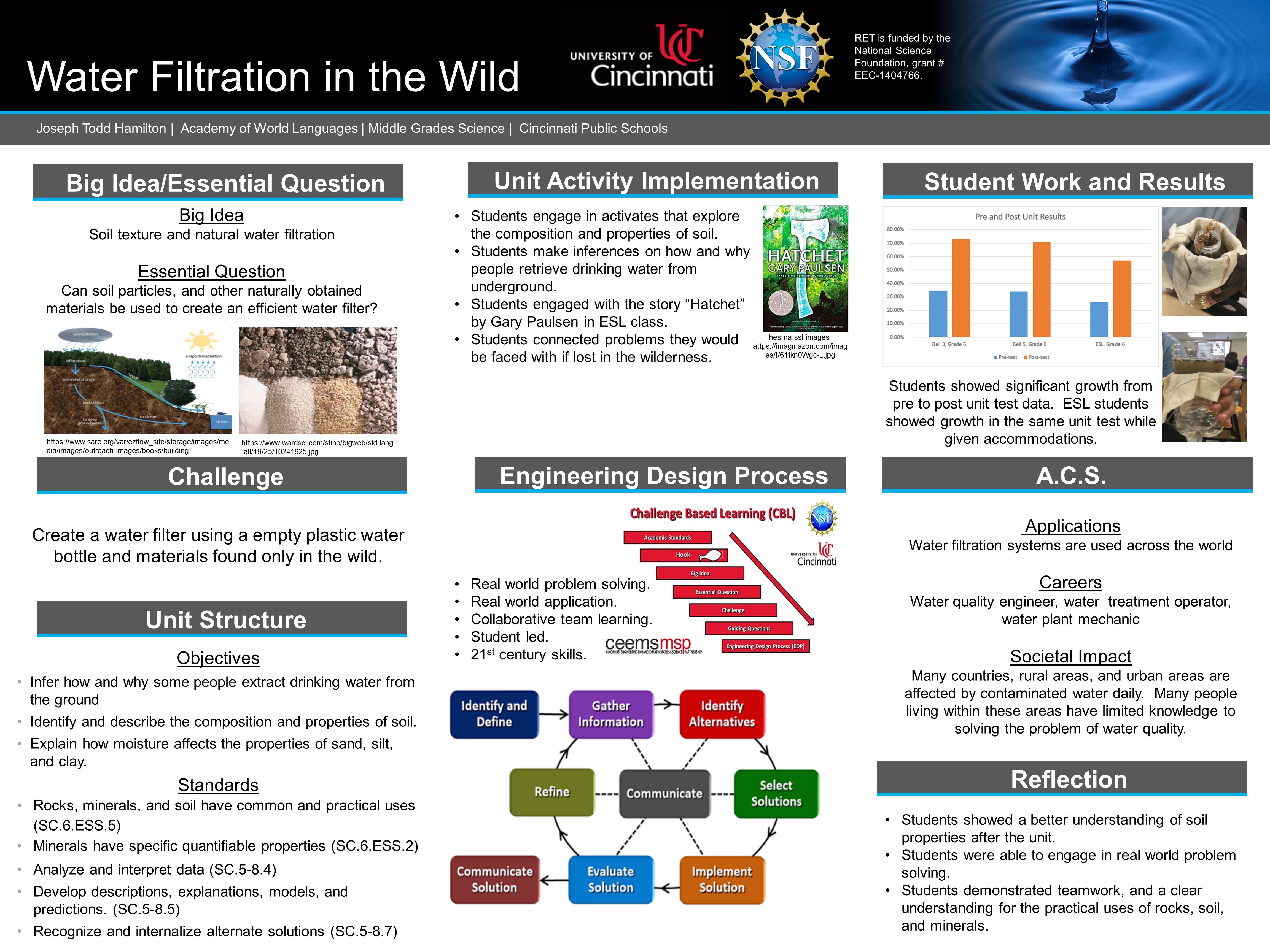Research Experience for Teachers (2017-2018)
Water Filtration in the Wilderness
 |
||||||
|
||||||
Keywords:
|
|
The Big Idea (including global relevance) Water is an essential need for all life. Clean water is not readily available for everyone. How can people clean water using simple, and abundant materials? |
|
Essential Questions What ways can water be cleaned using available and cheap materials? |
|
The Hook
|
|
The Challenge Students will create a water filter using readily available materials found in the wild or on their persons. |
|
Guiding Questions
|
ACS (Real world applications; career connections; societal impact)
Water filtration is an essential component for established cities. Many communities are left with challenges that limit resources to filter and clean water. Even in developed countries like the U.S. people are often faced with problems of contaminated water.
Basic water purification skills are important for people to know and understand in order to supply families and communities with the basic need for water.
Environmental engineer – Water quality video, guest speaker*; Soil conservationist – Field Trip (Green Acres)
Misconceptions
- Water is safe to drink if it is clear.
- Soil or sand can make water dirty and unsafe to drink.
Unit Lessons and Activities
- Lesson 1: Exploring Soil Profiles and the Composition/Properties of Soil Horizons. (7 days)
Lesson 1 will focus on giving students an understanding of how soil forms layers (horizons) based on the density of particles within the soil. Students will gain an understanding of how water infiltrates through a soil profile to become a part of larger underground river systems and aquifers. Students will explore the composition and properties of each horizon and study how these horizons develop given different environmental conditions.- Activity 1: Introduction to Big Idea, Generating the Essential Questions (Where did Jack and Jill get their water? Why?) Creating a Soil Profile (Soil sample shake in mason jar). (2 Days)
- Activity 2: Exploring Soil Horizons Composition and Properties, The Infiltration of Water Through a Soil Profile and Underground Water Systems. (5 Days)
- Lesson 2: Properties of Sand, Silt, Clay and Loam. Soil Triangles, and Water Infiltration/Absorption. (8 Days)
Lesson 2 will focus on giving students an understanding of the singular components of soil. Students will learn how to use a soil triangle to identify samples of soil and test these samples on how effective they are in allowing water infiltration or water absorption. Students will explore particle size and create theories on what could and could not pass through these particles. Students will then be challenged to design an effective water filtration system using only what they can find in nature.- Activity 3: Introduction to a Soil Triangle and the Properties of Sand, Silt, Clay, and Loam. (particle size exploration & sample identification) (3 Days)
- Activity 4: Effectiveness of Infiltration and Absorption Using Soil Samples (2 Days)
- Activity 5: Design and Test an Effective Water Filtration System Using Only Materials Found in Nature (3 Days)
- Evidence of CBL: Activities 1 and 5
- Evidence of EDP: Activity 5
Additional Resources
https://www.jpl.nasa.gov/edu/teach/activity/water-filtration-challenge/
